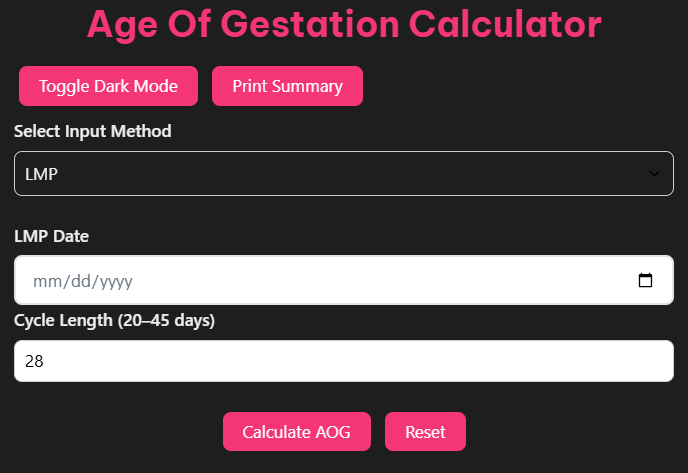Age Of Gestation Calculator
Gestational Age (AOG): -
Estimated Due Date (EDD): -
Current Trimester: -
Milestone Calendar
Pregnancy is an incredible journey, and one crucial aspect of managing it effectively is knowing the baby’s gestational age. Whether you’re an expectant parent planning the months ahead, a healthcare provider ensuring proper prenatal care, or a medical student learning the intricacies of obstetrics, our Free AOG Calculator can be your ultimate tool for accurate and quick gestational calculations.
What Is an AOG Calculator and Why Does It Matter?
An AOG Calculator helps determine the age of gestation, also referred to as fetal age. It estimates how far along a pregnancy is, usually measured in weeks and days from conception or the last menstrual period (LMP).
For parents, AOG offers vital information such as the estimated due date (EDD), while practitioners use it for tasks like prenatal planning, ultrasound assessments, and anomaly detection.
Knowing the correct gestational age helps ensure appropriate prenatal care, aids in monitoring fetal development, and enhances decision-making for maternity-related treatments or screenings.
How AOG Calculators Work
There are two primary methods used by AOG calculators to estimate gestational age:
1. Based on Last Menstrual Period (LMP)
The most conventional method, the LMP-based AOG calculation, marks the first day of the last menstrual period as the starting point. By default, a standard 28-day cycle is assumed, and a gestational period of 280 days (40 weeks) is added to determine the estimated due date.
However, adjustments can be input for those with irregular cycle lengths, ensuring personalized accuracy.
2. Via Ultrasound Data
For pregnancies where LMP recall is unreliable or absent, ultrasound scans offer an alternative. Using measurements like the Crown-Rump Length (CRL) during the first trimester, and parameters like Biparietal Diameter (BPD) in later trimesters, calculators can accurately determine gestational age.
Important Note: When both LMP and ultrasound data are available, credible calculators like our AOG Calculator prioritize ultrasound data, following ACOG-recommended guidelines.
Key Features of Our Free AOG Calculator 2025
A perfect tool for expectant parents and professionals, our Calculator offers invaluable features, including:
- LMP and Ultrasound Input Options: Provides flexibility for varying data availability.
- Customized Cycle Adjustment: Accurately calculates for cycle lengths other than the standard 28 days.
- Ultrasound Priority Setting: Prioritizes precise measures when ultrasound results differ from LMP estimations.
- User-Friendly Interface: Intuitive design ensures seamless navigation and quick calculations.
- Comprehensive Insights: Delivers both gestational age and expected due date in real-time.
How to Use Our AOG Calculator Step by Step

Step 1: Enter Details
Input either the first day of your last menstrual period or ultrasound-derived details, such as Crown-Rump Length (CRL) or Gestational Age (GA).
Step 2: Adjust Cycle Length (If Needed)
For women without a 28-day cycle, input the appropriate cycle duration. This feature is vital for those with irregular menstrual patterns.
Step 3: Calculate
Press the “Calculate” button and receive:
- The exact gestational age in weeks and days
- The estimated due date
Step 4: Use the Data
Whether you’re marking milestones in your pregnancy or aligning patient care plans, the results ensure actionable and confidence-backed decisions.
Real World Scenarios Using the Calculator
Here are practical examples demonstrating how the AOG Calculator makes a difference in various contexts:
- Scenario 1 (Expectant Mother): A mother recalls her LMP started on March 1, 2024. By entering this date, the calculator quickly determines her likely delivery date to be December 8, 2024.
- Scenario 2 (Healthcare Providers): A woman undergoing a scan at 10 weeks (with a CRL of 33mm) consults the AOG Calculator, which confirms alignment between gestational age and the ultrasound result.
- Scenario 3 (IVF Pregnancy): Dating from an IVF conception date of May 1, 2024, the calculator determines an estimated due date of January 23, 2025.
- Scenario 4 (Cycle Length Adjustment): For irregular cycles of 35 days, recalibration ensures the mother’s personalized estimation is as precise as possible.
Accuracy and Limitations
While AOG calculators are highly dependable tools, they do come with their limitations:
- Accuracy Relies on Input: Results based on incorrect LMP details or ultrasound readings can deviate significantly.
- Second and Third Trimester Challenges: Ultrasound dating tends to lose precision for later-stage pregnancies due to natural variability in fetal growth patterns.
- Clinical Context Needed: These calculators are supplementary tools; healthcare professionals should always guide final evaluations.
Expert Validation
According to Dr. Frank A. Chervenak in his study “How Accurate Is Fetal Biometry in the Assessment of Fetal Age,” early ultrasound metrics remain the gold standard for gestational estimations when LMP is uncertain.
Pro Tips for Accurate Use
To maximize the reliability of your results:
- Use Early Inputs: Enter LMP or first-trimester ultrasound details for the most accurate outcomes.
- Be Honest with Input: Ensure data like cycle irregularities or known discrepancies are accurately input.
- Double Check Results: Use multiple methods (LMP, ultrasound, or both) when available, and consult trusted healthcare providers for alignment.
The Role of AOG Calculators in Modern Obstetrics
The advent of advanced gestational tools like our Free AOG Calculator 2025 has transformed prenatal planning. Not only does it empower expectant parents with clarity and confidence, but it also aids professionals with accurate, reliable data for patient care decisions.
Want to experience the benefits firsthand?
Estimate gestational age today with our Free Calculator.